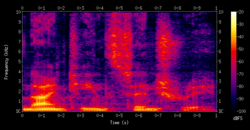Spektrogram

Spektrogram je vizuální reprezentace frekvenčního spektra signálu a jeho změny v čase. U audio signálů se často hovoří též o sonogramu.
Spektrogram se často používá mimo jiné v hudbě, v seismologii nebo při zpracování řeči. Ze spektrogramu řeči lze často rozpoznat jednotlivá slova, ornitologové poznají podle spektrogramu hlasy ptáků.
Na spektrogramu je zachycována proměna spektra v čase. Na vodorovné ose je zanesen čas, na svislé ose pak amplituda frekvence v daném čase. Ta je zachycena buďto stupněm šedé (tmavší odstín znamená zpravidla vyšší amplitudu) nebo barvou z nějaké předem zvolené barevné škály (tzv. teplotní mapa).
Odkazy
Reference
V tomto článku byl použit překlad textu z článku Spectrogram na anglické Wikipedii.
Externí odkazy
 Obrázky, zvuky či videa k tématu Spektrogram na Wikimedia Commons
Obrázky, zvuky či videa k tématu Spektrogram na Wikimedia Commons
Média použitá na této stránce
Digitally produced spectrogram of a male voice saying `nineteenth century'
